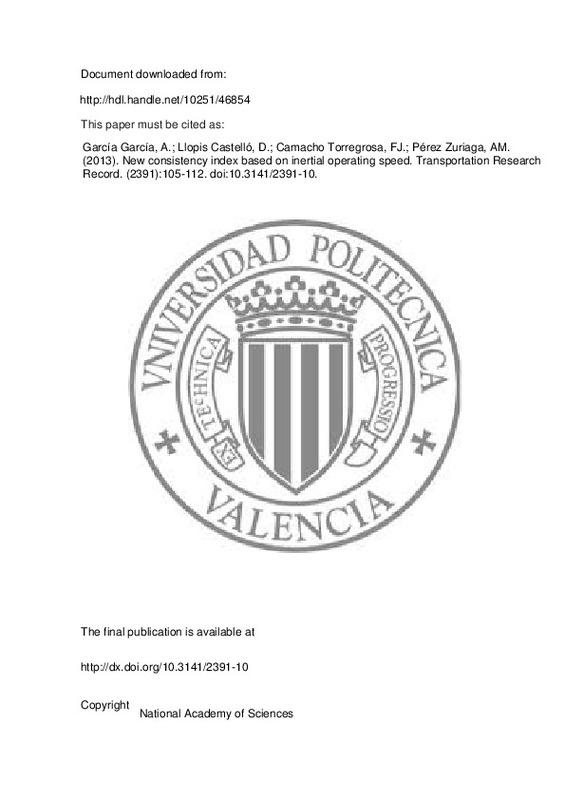JavaScript is disabled for your browser. Some features of this site may not work without it.
Buscar en RiuNet
Listar
Mi cuenta
Estadísticas
Ayuda RiuNet
Admin. UPV
New consistency index based on inertial operating speed
Mostrar el registro sencillo del ítem
Ficheros en el ítem
| dc.contributor.author | García García, Alfredo
|
es_ES |
| dc.contributor.author | Llopis Castelló, David
|
es_ES |
| dc.contributor.author | Camacho Torregrosa, Francisco Javier
|
es_ES |
| dc.contributor.author | Pérez Zuriaga, Ana María
|
es_ES |
| dc.date.accessioned | 2015-02-09T12:57:08Z | |
| dc.date.available | 2015-02-09T12:57:08Z | |
| dc.date.issued | 2013 | |
| dc.identifier.issn | 0361-1981 | |
| dc.identifier.uri | http://hdl.handle.net/10251/46854 | |
| dc.description.abstract | The occurrence of road crashes depends on several factors, with design consistency (i.e., conformance of highway geometry to drivers' expectations) being one of the most important. A new consistency model for evaluating the performance of tangent-to-curve transitions on two-lane rural roads was developed. This model was based on the inertial consistency index (ICI) defined for each transition. The ICI was calculated at the beginning point of the curve as the difference between the average operating speed on the previous 1-km road segment (inertial operating speed) and the actual operating speed at this point. For the calibration of the ICI and its thresholds, 88 road segments, which included 1,686 tangent-to-curve transitions, were studied. The relationship between those results and the crash rate associated with each transition was analyzed. The results showed that the higher the ICI was, the higher the crash rate; thus, the probability of accidents increased. Similar results were obtained from the study of the relationship between the ICI and the weighted average crash rate of the corresponding group of transitions. A graphical and statistical analysis established that road consistency might be considered good when the ICI was lower than 10 km/h, poor when the ICI was higher than 20 km/h, and fair otherwise. A validation process that considered 20 road segments was performed. The ICI values obtained were highly correlated to the number of crashes that had occurred at the analyzed transitions. Thus, the ICI and its consistency thresholds resulted in a new approach for evaluation of consistency. | es_ES |
| dc.description.sponsorship | The authors thank the Center for Studies and Experimentation of Public Works of the Spanish Ministry of Public Works, which partially subsidized the data collection, for obtaining the empirical operating speed profiles used in the validation process. The authors also thank the General Directorate of Public Works of the Infrastructure and Transportation Department of the Valencian government, the Valencian Province Council, and the General Directorate of Traffic of the Ministry of the Interior of the Government of Spain for their cooperation in data gathering. | en_EN |
| dc.language | Inglés | es_ES |
| dc.publisher | National Academy of Sciences | es_ES |
| dc.relation.ispartof | Transportation Research Record | es_ES |
| dc.rights | Reserva de todos los derechos | es_ES |
| dc.subject.classification | INGENIERIA E INFRAESTRUCTURA DE LOS TRANSPORTES | es_ES |
| dc.title | New consistency index based on inertial operating speed | es_ES |
| dc.type | Artículo | es_ES |
| dc.identifier.doi | 10.3141/2391-10 | |
| dc.rights.accessRights | Abierto | es_ES |
| dc.contributor.affiliation | Universitat Politècnica de València. Departamento de Ingeniería e Infraestructura de los Transportes - Departament d'Enginyeria i Infraestructura dels Transports | es_ES |
| dc.description.bibliographicCitation | García García, A.; Llopis Castelló, D.; Camacho Torregrosa, FJ.; Pérez Zuriaga, AM. (2013). New consistency index based on inertial operating speed. Transportation Research Record. (2391):105-112. doi:10.3141/2391-10 | es_ES |
| dc.description.accrualMethod | S | es_ES |
| dc.relation.publisherversion | http://dx.doi.org/10.3141/2391-10 | es_ES |
| dc.description.upvformatpinicio | 105 | es_ES |
| dc.description.upvformatpfin | 112 | es_ES |
| dc.type.version | info:eu-repo/semantics/publishedVersion | es_ES |
| dc.description.issue | 2391 | es_ES |
| dc.relation.senia | 251816 | |
| dc.contributor.funder | Centro de Estudios y Experimentación de Obras Públicas | es_ES |
| dc.description.references | Ng, J. C. ., & Sayed, T. (2004). Effect of geometric design consistency on road safety. Canadian Journal of Civil Engineering, 31(2), 218-227. doi:10.1139/l03-090 | es_ES |
| dc.description.references | Gibreel, G. M., Easa, S. M., Hassan, Y., & El-Dimeery, I. A. (1999). State of the Art of Highway Geometric Design Consistency. Journal of Transportation Engineering, 125(4), 305-313. doi:10.1061/(asce)0733-947x(1999)125:4(305) | es_ES |
| dc.description.references | Hassan, Y. (2004). Highway Design Consistency: Refining the State of Knowledge and Practice. Transportation Research Record: Journal of the Transportation Research Board, 1881(1), 63-71. doi:10.3141/1881-08 | es_ES |
| dc.description.references | Polus, A., & Mattar-Habib, C. (2004). New Consistency Model for Rural Highways and Its Relationship to Safety. Journal of Transportation Engineering, 130(3), 286-293. doi:10.1061/(asce)0733-947x(2004)130:3(286) | es_ES |
| dc.description.references | Cafiso, S., Di Graziano, A., Di Silvestro, G., La Cava, G., & Persaud, B. (2010). Development of comprehensive accident models for two-lane rural highways using exposure, geometry, consistency and context variables. Accident Analysis & Prevention, 42(4), 1072-1079. doi:10.1016/j.aap.2009.12.015 | es_ES |
| dc.description.references | Zuriaga, A. M. P., García, A. G., Torregrosa, F. J. C., & D’Attoma, P. (2010). Modeling Operating Speed and Deceleration on Two-Lane Rural Roads with Global Positioning System Data. Transportation Research Record: Journal of the Transportation Research Board, 2171(1), 11-20. doi:10.3141/2171-02 | es_ES |







![[Cerrado]](/themes/UPV/images/candado.png)

